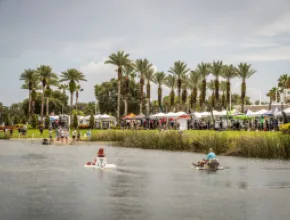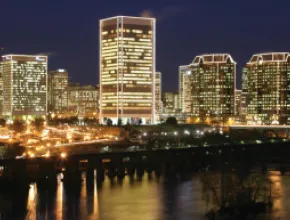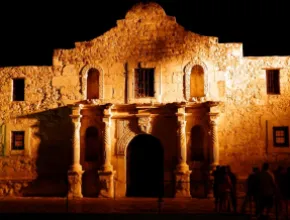Utilizing the slogan “The State of Independence,” Pennsylvania lays claim to a pivotal position in the country’s growth. With the American Revolution in the l8th century and Pennsylvania’s ability to hold the newly forming nation together like the keystone of an arch, it earned the nickname the Keystone State. Over the centuries, it has played a primary role in the country’s political, social and economic development.
The state’s enviable heritage provides planners with endless opportunities to enliven a meeting. Groups can soak up the atmosphere of by-gone eras by incorporating that history into their agendas.
Eastern Pennsylvania
While it was the nation’s capital for only a decade—from 1790 to 1800—Philadelphia played a significant role during the American Revolution and America’s early turbulent years.
The “City of Brotherly Love” has a remarkable legacy from that era: the “Nation’s Most Historic Square Mile,” chock-full of preserved historic buildings and attractions.
However, it has also built on its heritage this century with new visitor magnets on the edge of the historic square mile. Here stands the impressive National Constitution Center, the country’s first museum devoted to the Constitution, which can host 2,500 for gala events; the Independence Visitors Center, another off-site venue option; and the Liberty Bell Center.
Cashing in on what sets it apart, the Philadelphia CVB has incorporated the Liberty Bell in its marketing message, “Be at Liberty to Meet.”
“It’s as timeless and significant today as it was in 1776. History is alive on the streets of Philadelphia,” says Jack Ferguson, the CVB’s executive vice president of conventions.
“We are a big city with a small-town feel, where historic buildings have been developed into hotels,” he says. “This is where our nation was founded, where both the Declaration of Independence and the Constitution were written and signed.”
Many planners, especially in the medical and healthcare industries, find their associations and societies were founded in Philadelphia, he notes.
Ferguson says planners can take advantage of history and patriotism and incorporate red, white and blue in their colors and themes. Ben Franklin as master of ceremonies at an event or convention is popular, and there are lots of historical tour options for spouse programs.
Groups can meet at Carpenter’s Hall, where the First Continental Congress met, or the early Quaker Burlington Meeting House.
They can tour the colonial surgical amphitheater at the Pennsylvania Hospital, the country’s first hospital, or visit the historic Mutter Museum, famous for its medical anomalies.
There’s the Second Bank of the U.S., with its art galleries; Fireman’s Hall Museum in a restored firehouse (Franklin formed America’s first volunteer fire department in 1736); and, known for its ghost tours, the Eastern State Penitentiary, which dates to 1829.
Delegates at the Pennsylvania Convention Center, which will be doubled in size by early 2010, get the feel of a later period. It takes up part of the impressive and restored Reading Railroad Terminal, built in 1893, which also houses Reading Terminal Market’s restaurants and vendors.
King of Prussia in Montgomery County is a major suburban convention hub that is located 20 minutes west of downtown Philadelphia. Next to the 3,600-acre Valley Forge National Historical Park, site of Gen. George Washington’s winter encampment of 1777-’78, its living history attractions, historic sites and jogging trails provide a natural choice for a break between meetings.
Known for its gardens and arboreta collection, the county boasts 17 conferences centers. One is the IACC-certified Normandy Farm Hotel and Conference Center at Blue Bell, with high-tech meeting space in a restored historic cattle barn.
With more wineries than any other Pennsylvania county, Bucks County north of Philly promotes itself as a rural escape with intimate inns that are ideal for retreats. There are tours of mansions along the Delaware, the artist town of New Hope to explore and Washington Crossing Historic Park, where the Continental Army crossed the icy river on Christmas night in 1776.
Historic attractions that can be used as off-site venues include Mercer Museum & Fonthill Castle, built in 1912; Pennsbury Manor, the 17th century country estate of Pennsylvania founder William Penn; the 19th century Andalusia Estate on the Delaware; the Pearl S. Buck House; and the Michener Museum.
The state’s third-largest metro area is Lehigh Valley, located 60 miles northwest of Philadelphia in the Pocono foothills. Its three distinctive cities are Allentown, Bethlehem and Easton.
“Each city offers preserved historic sites and museums that are ideal for spousal tours, and some can accommodate evening events,” says Tracey Werner, public relations director of the Lehigh Valley CVB. “They make for a nice afternoon break, but one or two days can be allotted just for sightseeing.”
Werner describes downtown Bethlehem as a “must-see.”
“It’s quaint, easily walkable, with shopping and historic sites, and groups can have an evening dine-around at the many upscale, locally owned restaurants,” she says.
Founded by Moravian Church members in 1741, Bethlehem has downtown structures such as a tannery built in 1761, a grain mill built in 1869 and the Moravian Museum. A focal point is the Hotel Bethlehem, built in 1922, which can host up to 390 for banquets.
Coming in June 2009 will be Sands Bethworks, a major hotel-casino project of Las Vegas Sands. Many of the original buildings on the former Bethlehem Steel site will be preserved, and it will eventually feature the National Museum of Industrial History, a Smithsonian affiliate.
Located at the confluence of the Delaware and Lehigh Rivers, Easton has Centre Square with weekly farmers’ markets, the Crayola factory and the National Canal Museum.
Allentown, founded in 1762, boasts the country’s oldest civilian concert band and is noted for hiding the Liberty Bell from the British in 1777 and 1778 in the basement of a church.
World headquarters for Mack Trucks, the city will unveil America on Wheels this month, a 23,000-square-foot museum with event space dedicated to the history of road transportation. The city also has the Lehigh Valley Heritage Center, a regional history museum that also has event space.
To the northeast is Luzerne County, with Wilkes-Barre as its seat and Scranton nearby. The area’s coal mining and industrial heritage is preserved in attractions such as a coal mine tour, a historic mining village, an anthracite museum complex, and the Steamtown National Historic Site.
Without metro areas, the Pocono Mountains delivers a 2,400-square-mile, four-season playground.
Skytop Lodge at the base of the Poconos’ West Mountain was built as a grand resort in 1928. A member of Historic Hotels of America, the 5,000-acre property features an 18-hole golf course and 20,000 square feet of meeting space and can accommodate up to 350 for receptions.
On the edge of the Poconos in the Delaware River Highlands, Milford was laid out after the Revolutionary War. Several of its old buildings now sport antique shops and galleries.
The town’s illustrious hotel—Hotel Fauchere—was opened in 1852 by Louis Fauchere, master chef at New York’s Delmonico’s, and was run by the Fauchere family for 125 years.
Closed for 30 years, the hotel that has hosted presidents such as Theodore Roosevelt, Franklin Delano Roosevelt and John F. Kennedy reopened in summer 2006 following a five-year restoration.
The 16-room property, a member of Historic Hotels of America, has a small meeting room for eight people, plus an adjacent conference room for 30 people.
Central Pennsylvania
The rolling farmland of the central region embraces Harrisburg, the capital; nearby Hershey (the “Sweetest Place on Earth”); the Pennsylvania Dutch Country of Lancaster County; York; and Gettysburg National Military Park.
Harrisburg on the Susquehanna River, incorporated in 1791, has the Pennsylvania State Capitol to tour and attractions with venue space such as the National Civil War Museum, promoted as the country largest museum devoted to the war, and the State Museum of Pennsylvania.
Milton Hershey opened Hershey Park in 1907. Today it’s a year-round vacation and meeting and convention destination with theme parks and museums.
The Hotel Hershey, which opened in 1933 and was styled after a 19th century Mediterranean resort, has 23,000 square feet of Hershey’s meeting space, which includes a 100,000-square-foot convention center.
Conjuring the nostalgia of farming communities of earlier days, Pennsylvania Dutch Country is a unique showcase of the Amish, Mennonite and Brethren cultures. Lancaster County serves up lots of museums and a growing arts scene, a number of theaters, plenty of family attractions, farm tours, and historic towns and villages.
In October 2006, the Lancaster Arts Hotel debuted downtown in a restored and converted tobacco warehouse built in the 1880s. The boutique hotel features 63 rooms and suites and a restaurant, with a room that can seat 80 for banquets and an art gallery that can seat 30.
Next year, the new Lancaster County Convention Center will open within the facade of an old downtown Lancaster department store and feature a 45,000-square-foot exhibit hall, a 9,000-square-foot ballroom and more than 20,000 square feet of flexible prefunction space.
York, full of pretzel and potato chip companies, promotes itself as the “Snack Capital of the World,” but Abby Crooks, destination marketing manager of the York County CVB, says the area is “a true crossroads of history.”
“Meeting planners can incorporate history into their meeting by selecting a unique meeting facility or tours of key historic sites,” she says.
The Articles of Confederation were signed here in 1777, when the British occupied Philadelphia and “Yorktowne” was the capital for nine months.
York’s museums and historic sites include a replica of its colonial courthouse in the downtown Colonial Complex. Popular for history and architectural walking tours, downtown includes 20-plus building-size murals depicting the city’s history, a farmers’ market and The Yorktown Hotel–A Historic Hotel of America, which was built in 1925 and has 10,000 square feet of meeting space.
Crooks says reenactors and interpreters of the Civil War era are available to provide presentations at meetings, serve as toastmasters or simply greet guests to add a special touch to any function.
Historic off-site venue options include the County Heritage Trust Agricultural & Industrial Museum, featuring a circa-1829 grist mill; the York County Heritage Trust Historical Society Museum; and the Strand-Capitol Performing Arts Center.
The 1863 Gettysburg battle was fought in and around the town of Gettysburg, which is adjacent to Gettysburg National Military Park. Many of the town’s Civil War-era buildings remain, including the restored Lincoln train station, which reopened last July and has event space.
The new $125 million Gettysburg Museum and Visitor Center will open at the military park this month. A project of the National Park Service and Gettysburg Foundation, the 139,000-square-foot building will include theaters and 11 exhibit galleries.
With 7,000 square feet of meeting space, the Gettysburg Hotel dates back to 1797, and its present building to 1922. At the height of the Cold War, it served as President Dwight D. Eisenhower’s operations center while he recuperated from a heart attack at his nearby farm, which is open to the public and is one of the area’s many attractions.
To the north, near the state’s center, is State College, home to Penn State University (PSU), and nearby historic towns and mountain recreation areas. With tree-lined streets, the college town is packed with coffee houses and art galleries.
“Downtown State College is a terrific place to unwind after all-day meetings, with shops, restaurants and nightlife spots,” says Christie Black, director of marketing for the Central Pennsylvania CVB.
Nearby Boalsburg is home to the Pennsylvania Military Museum, the Boal Mansion Museum and Duffy’s Tavern, once a stagecoach stop.
The Nittany Lion Inn on the PSU campus has meeting space for 500 people and is a member of Historic Hotels of America.
Bedford Springs, midway between Pittsburgh and Harrisburg off the Pennsylvania Turnpike in the Southern Allegheny Mountains, is known for its century-old covered bridges; Bedford County has 14.
Among downtown’s old buildings is the Espy House, President George Washington’s headquarters during the 1794 Whiskey Rebellion. Sites include the Fort Bedford Museum, the Log Church and Old Bedford Village, featuring vintage restored buildings.
The new historic superstar is the Benchmark Hospitality-managed Bedford Springs Resort. Closed since 1986, the historic hotel opened last summer following a three-year, $108 million restoration and expansion.
The resort has 218 rooms, a 30,000-square-foot spa, 20,000 square feet of meeting space, and a renovated Donald Ross-designed golf course.
Its Frontier Tavern is in a stone building dating to 1806 when the hotel opened. The original glass in the windows of the Crystal Ballroom bear the inscriptions of brides who were married at the hotel in the 19th century.
President James Buchanan received the first telegram on the first trans-Atlantic telegraph cable (from Queen Victoria in 1858) in the lobby. A Lancaster native, he spent 40 summers at the Bedford Springs Hotel, his “summer White House.”
Western Pennsylvania
Founded in 1758 where the Allegheny and Monongahela rivers meet, Pittsburgh is celebrating its 250th birthday this year. The British built Fort Pitt at what is now “The Point” downtown after the French were defeated in the area during the French and Indian War.
Although it became an industrial giant, “Steel Town” and the smokestacks are long gone.
“We’re recognized by Places Rated Almanac as ‘America’s Most Livable City,’” says Craig Davis, Visit Pittsburgh’s vice president of sales and marketing. “We’ve come a long way in 250 years. There will be lots of celebrations so this year is a perfect time to visit Pittsburgh.”
Meeting planners, he says, can set up walking tours through the Pittsburgh History & Landmarks Foundation or take bridge tours. (The city has 446 bridges.)
“From any downtown hotel, visitors can walk to the Fort Pitt Museum or ride one of our historic funiculars—the Duquesne or Monongahela inclines—to the top of Mt. Washington to get the perfect bird’s-eye view of the city and rivers,” he explains.
The Fort Pitt Museum is located in the 36-acre Point State Park, which is undergoing a $35 million renovation. Part of the park will open this summer and the project will be completed by November, although the museum and its historic blockhouse have remained open.
Popular off-site venues include the Heinz Pittsburgh Regional History Center and the Frick Art & Historical Center.
The Monroeville area east of Pittsburgh is also home to sites dating to the 1800s, such as the McGinley House, the Old Stone Church and the McCully Log House.
Just northeast of Pittsburgh, Butler County is another historically rich, group-friendly destination that preserves its past with historic sites such as the Butler County Heritage Center, the Cooper Cabin Pioneer Homestead and the Lowrie/Shaw House.
Butler County’s historic venue options include the Grand Ballroom at Cornerstone Commons, situated in a century-old building, and Armstrong Farms Bed and Breakfast, featuring a 125-person conference area set amid two restored 19th century barns.
The French and Indian War also gave birth to the communities of the Laurel Highlands in the Alleghenies, 50 miles from the city and also commemorating a 250th anniversary this year.
Top sites are Fort Necessity and Fort Ligonier, which have a schedule of special events and reenactments scheduled this year. With a new interpretive and education center, Fort Necessity is a short walk to the Great Meadow where Col. George Washington led his troops. Fort Ligonier is a full-scale reconstruction on the site of the original fort built in 1758.
“Meeting planners have fascinating opportunities to incorporate French and Indian War history into their groups’ itineraries,” says Ann Nemanic, tourism services manager at the Laurel Highlands Visitors Bureau. “It surprises them to learn that Washington’s military career began in the Laurel Highlands.”
Planners, she says, should know that these historic sites are close to resorts and other area attractions, including three Frank Lloyd Wright homes (Fallingwater, Kentuck Knob and the Duncan House), and Nemacolin Woodlands Resort and Seven Springs Mountain Resort.
The city of Erie, which opened its $100 million Bayfront Convention Center last summer, places a big emphasis on recreation and the great outdoors, but it also has its share of heritage attractions. They include the Erie Maritime Museum and the Brig Niagara, veteran of the War of 1812; the Firefighters Historic Museum; and the Erie Historical Society, which features museums and a mansion that is available for events.
For More Info
Allegheny Mountains CVB 814.943.4183
www.amcvb.com
215.639.0300
www.experiencebuckscounty.com
724.234.4619
www.visitbutlercounty.com
814.231.1400
www.centralpacvb.org
412.856.7422
www.visitmonroeville.com
717.334.6274
www.gettysburgcvb.org
717.231.7788
www.hersheyharrisburg.org
814.536.7993
www.visitjohnstownpa.com
724.238.5661
www.laurelhighlands.org
610.882.9200
www.lehighvalleypa.org
570.819.1877
www.tournepa.com
717.299.8901
www.padutchcountry.com
215.636.3300
www.philadelphiausa.travel
570.421.5791
www.poconomeetings.com
610.834.1550
www.valleyforge.org
814.454.7191
www.visiteriepa.com
412.281.7711
www.visitpittsburgh.com
888.858.9675
www.yorkpa.org






